Melt Inclusions in Plagioclase Macrocrysts at Mount Jourdanne, Southwest Indian Ridge (~64° E): Implications for an Enriched Mantle Source and Shallow Magmatic Processes
Abstract
:1. Introduction
2. Geological Setting
3. Samples and Petrography
4. Analytical Methods
4.1. Electron Microprobe Analysis (EPMA)
4.2. LA-ICP-MS Analyses
4.3. Whole Rock Analysis
5. Results
5.1. Plagioclase Major Element Compositions
5.2. Whole-Rock and PUB Matrix Glass Compositions
5.3. Plagioclase-Hosted Melt Inclusions
6. Discussion
6.1. Post-Entrapment Crystallization (PEC) and Diffusive Equilibration
6.2. Insights into the Mantle Source Lithologies of Mount Jourdanne Basalts and the 61–67° E Basaltic Lavas
6.3. Melt/Mantle Reactions: Insight from Mount Jourdanne PUBs and Spatially Related Plagioclase-Bearing (Ultra)Mafic Rocks
6.4. The Petrogenetic Model for the Mount Jourdanne PUBs at ~64° E
7. Conclusions
Supplementary Materials
Author Contributions
Funding
Acknowledgments
Conflicts of Interest
References
- O’Hara, M.J. Are ocean floor basalt primary magma? Nature 1968, 220, 683–686. [Google Scholar] [CrossRef]
- Rubin, K.H.; Sinton, J.M.; Maclennan, J.; Hellebrand, E. Magmatic filtering of mantle compositions at mid-ocean-ridge volcanoes. Nat. Geosci. 2009, 2, 321–328. [Google Scholar] [CrossRef]
- Shorttle, O. Geochemical variability in MORB controlled by concurrent mixing and crystallization. Earth Planet. Sci. Lett. 2015, 424, 1–14. [Google Scholar] [CrossRef]
- Kent, A.J.R. Melt inclusions in basaltic and related volcanic rocks. Rev. Mineral. Geochem. 2008, 69, 273–331. [Google Scholar] [CrossRef]
- Schiano, P. Primitive mantle magmas recorded as silicate melt inclusions in igneous minerals. Earth-Sci Rev. 2003, 63, 121–144. [Google Scholar] [CrossRef]
- Shimizu, N. The geochemistry of olivine-hosted melt inclusions in a FAMOUS basalt ALV519-4-1. Phys. Earth Planet. Int. 1998, 107, 183–201. [Google Scholar]
- Sobolev, A.V. Melt inclusions in minerals: A source of principle petrological information. Petrology 1996, 4, 209–220. [Google Scholar]
- Frezzotti, M.L. Silicate-melt inclusions in magmatic rocks: Applications to petrology. Lithos 2001, 55, 273–299. [Google Scholar] [CrossRef]
- Sinton, J.M.; Detrick, R.S. Mid-Ocean Ridge Magma Chambers. J. Geophys. Res. 1992, 97, 197–216. [Google Scholar] [CrossRef]
- Sobolev, A.V.; Shimizu, N. Ultra-depleted primary melt included in an olivine from the Mid-Atlantic Ridge. Nature 1996, 363, 151–154. [Google Scholar] [CrossRef]
- Sours-Page, R.; Johnson, K.T.M.; Nielsen, R.L.; Karsten, J.L. Local and regional variation in MORB parent magmas: Evidence from melt inclusions from the Endeavour Segment of the Juan de Fuca Ridge. Contrib. Mineral. Petrol. 1999, 134, 342–363. [Google Scholar] [CrossRef]
- Sours-Page, R.; Nielsen, R.L.; Batiza, R. Melt inclusions as indicators of parental magma diversity on the northern East Pacific Rise. Chem. Geol. 2002, 183, 237–261. [Google Scholar] [CrossRef]
- Fowler, C.M.R. Crustal structure of the Mid-Atlantic ridge crest at 37° N. Geophys. J. R. Astron. Soc. 1976, 47, 459–491. [Google Scholar] [CrossRef]
- Fowler, C.M.R. The Mid-Atlantic Ridge: Structure at 45° N. Geophys. J. Int. 1978, 54, 167–183. [Google Scholar] [CrossRef]
- Purdy, G.M.; Detrick, R.S. Crustal structure of the Mid-Atlantic Ridge at 23° N from seismic refraction studies. J. Geophys. Res. 1986, 91, 3739–3762. [Google Scholar] [CrossRef]
- Cullen, A.; Vicenzi, E.; McBirney, A.R. Plagioclase ultraphyric basalts of the Galapagos archipelago. J. Volcanol. Geotherm. Res. 1989, 37, 325–337. [Google Scholar] [CrossRef]
- Flower, M.F.J. Accumulation of calcic plagioclase in ocean-ridge tholeiite: An indication of spreading rate? Nature 1980, 287, 530–532. [Google Scholar] [CrossRef]
- Hellevang, B.; Pedersen, R.B. Magma ascent and crustal accretion at ultraslow-spreading ridges: Constraints from plagioclase ultraphyric basalts from the Arctic mid-ocean ridge. J. Petrol. 2008, 49, 267–294. [Google Scholar] [CrossRef]
- Kuo, L.C.; Kirkpatrick, R. Pre-eruption history of phyric basalt from DSDP Legs 45 and 46: Evidence from morphology and zoning patterns in plagioclase. Contrib. Mineral. Petrol. 1982, 79, 13–27. [Google Scholar] [CrossRef]
- Lange, A.E.; Nielsen, R.L.; Tepley, F.J.; Kent, A.J.R. The petrogenesis of plagioclase-phyric basalts at mid-ocean ridges. Geochem. Geophys. Geosyst. 2013, 14, 3282–3296. [Google Scholar] [CrossRef]
- le Roex, A.P.; Frey, F.A.; Richardson, S.H. Petrogenesis of lavas from the AMAR Valley and Narrowgate region of the FAMOUS Valley, 36–37° N on the Mid-Atlantic Ridge. Contrib. Mineral. Petrol. 1996, 124, 167–184. [Google Scholar] [CrossRef]
- Sinton, C.; Christie, D.; Coombs, V. Near-primary melt inclusions in anorthite phenocrysts from the Galapagos Platform. Earth Planet. Sci. Lett. 1993, 119, 527–537. [Google Scholar] [CrossRef]
- Weinsteiger, A.B. The Origin of Mid-ocean Ridge Basalts: Insights from Trace Element Contents in Anorthite, Anorthite-hosted Melt Inclusions, and Ocean Core Complexes. Ph.D. Thesis, Oregon State University, Corvallis, OR, USA, 2010; pp. 1–466. [Google Scholar]
- Neave, D.A.; Hartley, M.E.; Maclennan, J.; Edmonds, M.; Thordarson, T. Volatile and light lithophile elements in high-anorthite plagioclase-hosted melt inclusions from Iceland. Geochim. Cosmochim. Acta 2017, 205, 100–118. [Google Scholar] [CrossRef]
- Nielsen, R.L.; Crum, J.; Bourgeois, R.; Hascall, K.; Forsythe, L.M.; Fisk, M.R.; Christie, D.M. Melt inclusions in high-An plagioclase from the Gorda Ridge: An example of the local diversity of MORB parent magmas. Contrib. Mineral. Petrol. 1995, 122, 34–50. [Google Scholar] [CrossRef]
- Panjasawatwong, Y.; Danyushevsky, L.V.; Crawford, A.J.; Harris, K.L. An experimental study of the effects of melt composition on plagioclase-melt equilibria at 5 and 10 kbar: Implications for the origin of magmatic high—An plagioclase. Contrib. Mineral. Petrol. 1995, 118, 420–432. [Google Scholar] [CrossRef]
- Hansen, H.; Grönvold, K. Plagioclase ultraphyric basalts in Iceland: The mush of the rift. J. Volcanol. Geotherm. Res. 2000, 98, 1–32. [Google Scholar] [CrossRef]
- Cannat, M.; Sauter, D.; Bezos, A.; Meyzen, C.; Humler, E.; Le Rigoleur, M. Spreading rate, spreading obliquity, and melt supply at the ultraslow spreading Southwest Indian Ridge. Geochem. Geophys. Geosyst. 2008, 9, Q04002. [Google Scholar] [CrossRef]
- Meyzen, C.M.; Toplis, M.J.; Humler, E.; Ludden, J.N.; Mével, C. A discontinuity in mantle composition beneath the southwest Indian ridge. Nature 2003, 421, 731–733. [Google Scholar] [CrossRef]
- Paquet, M.; Cannat, M.; Brunelli, D.; Hamelin, C.; Humler, E. Effect of melt/mantle interactions on MORB chemistry at the easternmost Southwest IndianRidge (61°–67° E). Geochem. Geophys. Geosyst. 2016, 17, 4605–4640. [Google Scholar] [CrossRef]
- Patriat, P.; Sloan, H.; Sauter, D. From slow to ultra-slow: A previously undetected event at the Southwest Indian Ridge at ca. 24 Myr. Geology 2008, 36, 207–210. [Google Scholar] [CrossRef]
- Cannat, M.; Rommevaux-Jestin, C.; Sauter, D.; Deplus, C.; Mendel, V. Formation of the axial relief at the very slow spreading Southwest Indian Ridge (49°–69° E). J. Geophys. Res. 1999, 104, 22825–22843. [Google Scholar] [CrossRef]
- Cannat, M.; Sauter, D.; Mendel, V.; Ruellan, E.; Okino, K.; Escartin, J.; Combier, V.; Baala, M. Modes of seafloor generation at a melt-poor ultraslow-spreading ridge. Geology 2006, 34, 605–608. [Google Scholar] [CrossRef]
- Muller, M.R.; Minshull, T.A.; White, R.S. Segmentation and melt supply at the Southwest Indian Ridge. Geology 1999, 27, 867–870. [Google Scholar] [CrossRef]
- Sauter, D.; Cannat, M.; Rouméjon, S.; Andreani, M.; Birot, D.; Bronner, A.; Brunelli, D.; Carlut, J.; Delacour, A.; Guyader, V.; et al. Continuous exhumation of mantle-derived rocks at the Southwest Indian Ridge for 11 million years. Nat. Geosci. 2013, 6, 314–320. [Google Scholar] [CrossRef] [Green Version]
- Cannat, M.; Rommevaux-Jestin, C.; Fujimoto, H. Melt supply variations to a magma-poor ultra-slow spreading ridge (Southwest Indian Ridge 61° to 69° E). Geochem. Geophys. Geosyst. 2003, 4, 9104. [Google Scholar] [CrossRef]
- Wessel, P.; Smith, W.H.F.; Scharroo, R.; Luis, J.; Wobbe, F. Generic Mapping Tools: Improved Version Released. Eos Trans. Am. Geophys. Union 2013, 94, 409–410. [Google Scholar] [CrossRef] [Green Version]
- Bralee, A.V. A detailed geophysical study of the ultra-slow spreading Southwest Indian Ridge: The axis of segment 11 near 64° E. Ph.D. Thesis, Department of Geological Science, University of Durham, Durham, UK, 2003. [Google Scholar]
- Mével, C. Investigating an ultraslow spreading ridge: The first results of the FUJI cruise on the SWIR (R/V Marion Dufresne, 7/10–3/11/97). InterRidge News 1998, 7, 29–32. [Google Scholar]
- Searle, R.C.; Cannat, M.; Fujioka, K.; Mevel, C.; Fujimoto, H.; Bralee, A.; Parson, L. FUJI Dome: A large detachment fault near 64 degrees E on the very slow-spreading southwest Indian Ridge. Geochem. Geophys. Geosyst. 2003, 4, 9105. [Google Scholar] [CrossRef]
- Münch, U.; Lalou, C.; Halbach, P.; Fujimoto, H. Relict hydrothermal events along the super-slow Southwest Indian spreading ridge near 63°56’ E–mineralogy, chemistry and chronology of sulfide samples. Chem. Geol. 2001, 177, 341–349. [Google Scholar] [CrossRef]
- Valer, M.; Bachèlery, P.; Schiano, P. The petrogenesis of plagioclase-phyric basalts from La Réunion Island. J. Petrol. 2017, 58, 675–698. [Google Scholar] [CrossRef]
- Neave, D.A.; Maclennan, J.; Hartley, M.E.; Edmonds, M.; Thordarson, T. Crystal storage and transfer in basaltic systems: The Skuggafjöll eruption, Iceland. J. Petrol. 2014, 55, 2311–2346. [Google Scholar] [CrossRef]
- Liu, Y.; Hu, Z.; Gao, S.; Günther, D.; Xu, J.; Gao, C.; Chen, H. In situ analysis of major and trace elements of anhydrous minerals by LA-ICP-MS without applying an internal standard. Chem. Geol. 2008, 257, 34–43. [Google Scholar] [CrossRef]
- Smith, M.C.; Perfit, M.R.; Fornari, D.J.; Ridley, W.I.; Edwards, M.H.; Jurras, G.J.; Von Damm, K.L. Magmatic processes and segmentation at a fast spreading mid-ocean ridge: Detailed investigation of an axial discontinuity on the East Pacific Rise crest at 9°37’ N. Geochem. Geophys. Geosyst. 2001, 2, 2000GC000134. [Google Scholar] [CrossRef]
- Sun, S.; McDonough, W.F. Chemical and isotopic systematics of oceanic basalts: Implications for mantle composition and processes. Geol. Soc. Spec. Publ. 1989, 42, 313–345. [Google Scholar] [CrossRef]
- McDonough, W.F.; Sun, S.S. The composition of the Earth. Chem. Geol. 1995, 120, 223–253. [Google Scholar] [CrossRef]
- Cottrell, E.; Spiegelman, M.; Langmuir, C.H. Consequences of diffusive reequilibration for the interpretation of melt inclusions. Geochem. Geophys. Geosyst. 2002, 3, 1–26. [Google Scholar] [CrossRef] [Green Version]
- Danyushevsky, L.V.; Mcneill, A.W.; Sobolev, A.V. Experimental and petrological studies of melt inclusions in phenocrysts from mantle-derived magmas: An overview of techniques, advantages and complications. Chem. Geol. 2002, 183, 5–24. [Google Scholar] [CrossRef]
- Nielsen, R.L. The effects of re-homogenization on plagioclase hosted melt inclusions. Geochem. Geophys. Geosyst. 2011, 12, Q0AC17. [Google Scholar] [CrossRef]
- Danyushevsky, L.V.; Plechov, P. Petrolog3: Integrated software for modeling crystallization processes. Geochem. Geophys. Geosyst. 2011, 12, Q07021. [Google Scholar] [CrossRef]
- Danyushevsky, L.V. The effect of small amounts of H2O on crystallization of mid-ocean ridge and backarc basin magmas. J. Volcanol. Geotherm. Res. 2001, 110, 265–280. [Google Scholar] [CrossRef]
- Michael, P.J.; McDonough, W.F.; Nielsen, R.L.; Cornell, W.C. Depleted melt inclusions in MORB plagioclase: Messages from the mantle or mirages from the magma chamber? Chem. Geol. 2002, 183, 43–61. [Google Scholar] [CrossRef]
- Frey, F.A.; Silva, I.G.N.; Huang, S.; Pringle, M.S.; Meleney, P.R.; Weis, D. Depleted components in the source of hotspot magmas: Evidence from the Ninetyeast Ridge (Kerguelen). Earth Planet. Sci. Lett. 2015, 426, 293–304. [Google Scholar] [CrossRef] [Green Version]
- Fitton, J.G.; Saunders, A.D.; Norry, M.J.; Hararson, B.S.; Taylor, R.N. Thermal and chemical structure of the Iceland plume. Earth Planet. Sci. Lett. 1997, 153, 197–208. [Google Scholar] [CrossRef]
- Condie, K.C. Incompatible element ratios in oceanic basalts and komatiites: Tracking deep mantle sources and continental growths with time. Geochem. Geophys. Geosyst. 2003, 4, 1–28. [Google Scholar] [CrossRef]
- le Roux, P.J.; le Roex, A.P.; Schilling, J.G.; Shimizu, N.; Perkins, W.W.; Pearce, N.J.G. Mantle heterogeneity beneath the southern Mid-Atlantic Ridge: Trace element evidence for contamination of ambient asthenospheric mantle. Earth Planet. Sci. Lett. 2002, 203, 479–498. [Google Scholar] [CrossRef]
- Sobolev, A.V.; Hofmann, A.W.; Kuzmin, D.V.; Yaxley, G.M.; Arndt, N.T.; Chung, S.; Danyushevsky, L.V.; Elliott, T.; Frey, F.A.; Garcia, M.O.; et al. The amount of recycled crust in sources of mantle-derived melts. Science 2007, 316, 412–417. [Google Scholar] [CrossRef]
- Zhang, G.; Zong, C.; Yin, X.; Li, H. Geochemical constraints on a mixed pyroxenite-peridotite source for East Pacific Rise basalts. Chem. Geol. 2012, 330–331, 176–187. [Google Scholar] [CrossRef]
- Yang, Z.; Li, J.; Liang, W.; Luo, Z. On the chemical markers of pyroxenite contributions in continental basalts in Eastern China: Implications for source lithology and the origin of basalts. Earth-Sci. Rev. 2016, 157, 18–31. [Google Scholar] [CrossRef] [Green Version]
- Yang, Z.; Li, J.; Jiang, Q.; Xu, F.; Guo, S.; Li, Y.; Zhang, J. Using major element logratios to recognize compositional patterns of basalt: Implications for source lithological and compositional heterogeneities. J. Geophys. Res. 2019, 124. [Google Scholar] [CrossRef]
- Le Roux, V.; Lee, C.T.A.; Turner, S.J. Zn/Fe systematics in mafic and ultramafic systems: Implications for detecting major element heterogeneities in the Earth’s mantle. Geochim. Cosmochim. Acta 2010, 74, 2779–2796. [Google Scholar] [CrossRef]
- Le Roux, V.; Dasgupta, R.; Lee, C.T.A. Mineralogical heterogeneities in the Earth’s mantle: Constraints from Mn, Co, Ni and Zn partitioning during partial melting. Earth Planet. Sci. Lett. 2011, 307, 395–408. [Google Scholar] [CrossRef]
- Herzberg, C.; Asimow, P.D. Petrology of some oceanic island basalts: PRIMELT2.XLS software for primary magma calculation. Geochem. Geophys. Geosyst. 2008, 9, Q09001. [Google Scholar] [CrossRef]
- Yang, Z.; Zhou, J. Can we identify source lithology of basalt? Sci. Rep. 2013, 3, 1856. [Google Scholar] [CrossRef]
- Seyler, M.; Cannat, M.; Mével, C. Evidence for major-element heterogeneity in the mantle source of abyssal peridotites from the Southwest Indian Ridge (52° to 68° E). Geochem. Geophys. Geosyst. 2003, 4, 9101. [Google Scholar] [CrossRef]
- Seyler, M.; Brunelli, D.; Toplis, M.J.; Mével, C. Multiscale chemical heterogeneities beneath the eastern Southwest Indian Ridge (52° E–68° E): Trace element compositions of along-axis dredged peridotites. Geochem. Geophys. Geosyst. 2011, 12, Q0AC15. [Google Scholar] [CrossRef]
- Li, W.; Soustelle, V.; Jin, Z.; Li, H.; Chen, T.; Tao, C. Origins of water content variations in the sub-oceanic upper mantle: Insight from Southwest Indian Ridge abyssal peridotites. Geochem. Geophys. Geosyst. 2017, 18, 1298–1329. [Google Scholar] [CrossRef]
- Brunelli, D.; Paganelli, E.; Seyler, M. Percolation of enriched melts during incremental open-system melting in the spinel field: A REE approach to abyssal peridotites from the Southwest Indian Ridge. Geochim. Cosmochim. Acta 2014, 127, 190–203. [Google Scholar] [CrossRef]
- Davis, F.A.; Humayun, M.; Hirschmann, M.M.; Cooper, R.S. Experimentally determined mineral/melt partitioning of first-row transition elements (FRTE) during partial melting of peridotite at 3 GPa. Geochim. Cosmochim. Acta 2013, 104, 232–260. [Google Scholar] [CrossRef]
- Gurenko, A.A.; Chaussidon, M. Enriched and depleted primitive melts included in olivine from Icelandic tholeiites: Origin by continuous melting of a single mantle column. Geochim. Cosmochim. Acta 1995, 59, 2905–2917. [Google Scholar] [CrossRef]
- Dick, H.J.B.; Lissenberg, J.; Warren, J.M. Mantle melting, melt transport, and delivery beneath a slow-spreading ridge: The paleo-MAR from 23°15’ N to 23°45’ N. J. Petrol. 2010, 51, 425–467. [Google Scholar] [CrossRef]
- Tamura, A.; Arai, S.; Ishimaru, S.; Andal, E.S. Petrology and geochemistry of peridotites from IODP Site U1309 at Atlantis Massif, MAR 30° N: Micro-and macro-scale melt penetrations in peridotite. Contrib. Mineral. Petrol. 2008, 155, 491–509. [Google Scholar] [CrossRef]
- Higgins, M.D.; Chandrasekharam, D. Nature of subvolcanic magma chambers, Deccan Province, India: Evidence from quantitative textural analysis of plagioclase megacrysts in the giant plagioclase basalts. J. Petrol. 2007, 48, 885–900. [Google Scholar] [CrossRef]
- Sheth, H. Giant plagioclase basalts: Continental flood basalt-induced remobilization of anorthositic mushes in a deep crustal sill complex. Geol. Soc. Am. Bull. 2016, 128, 916–925. [Google Scholar] [CrossRef]
- Yamada, T.; Tamaki, K.; Fujimoto, H.; Kanazawa, T. Microearthquakes characteristics at the Jourdanes segment: Seismic experiment at 64° E (SWIR). Paper presented at InterRidge South West Indian Ridge Workshop, Southampton, UK, 17–20 April 2002. [Google Scholar]
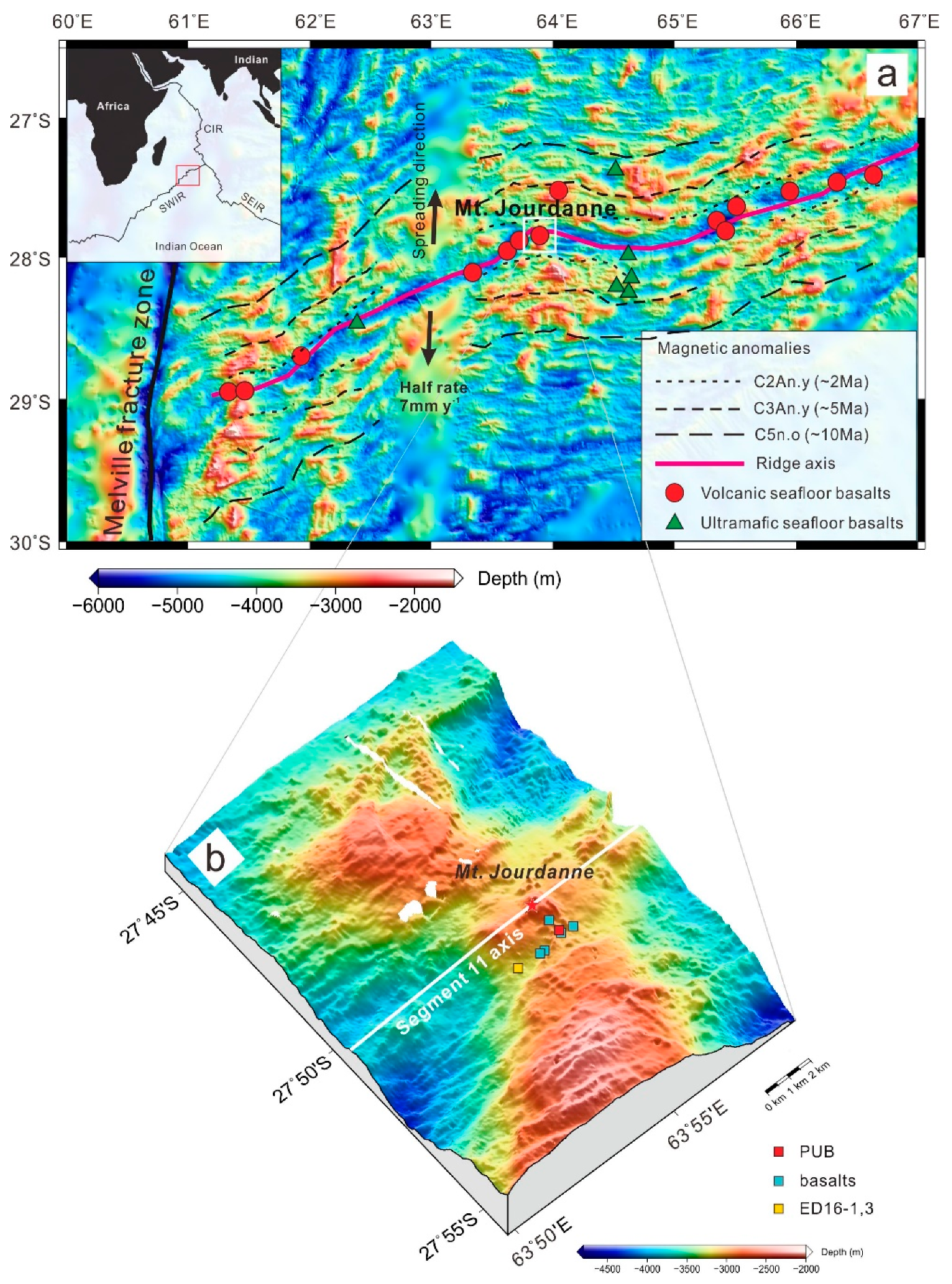

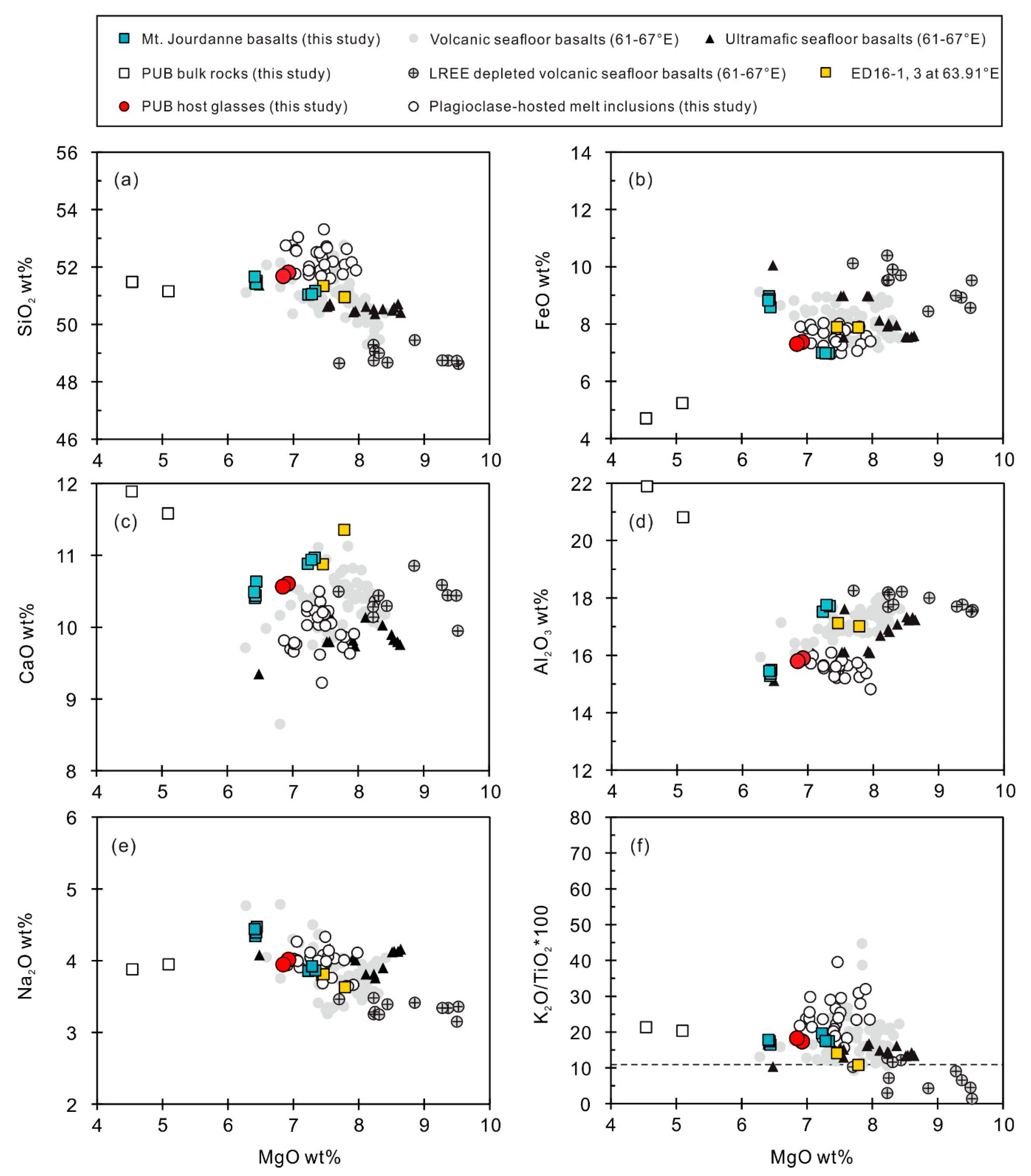
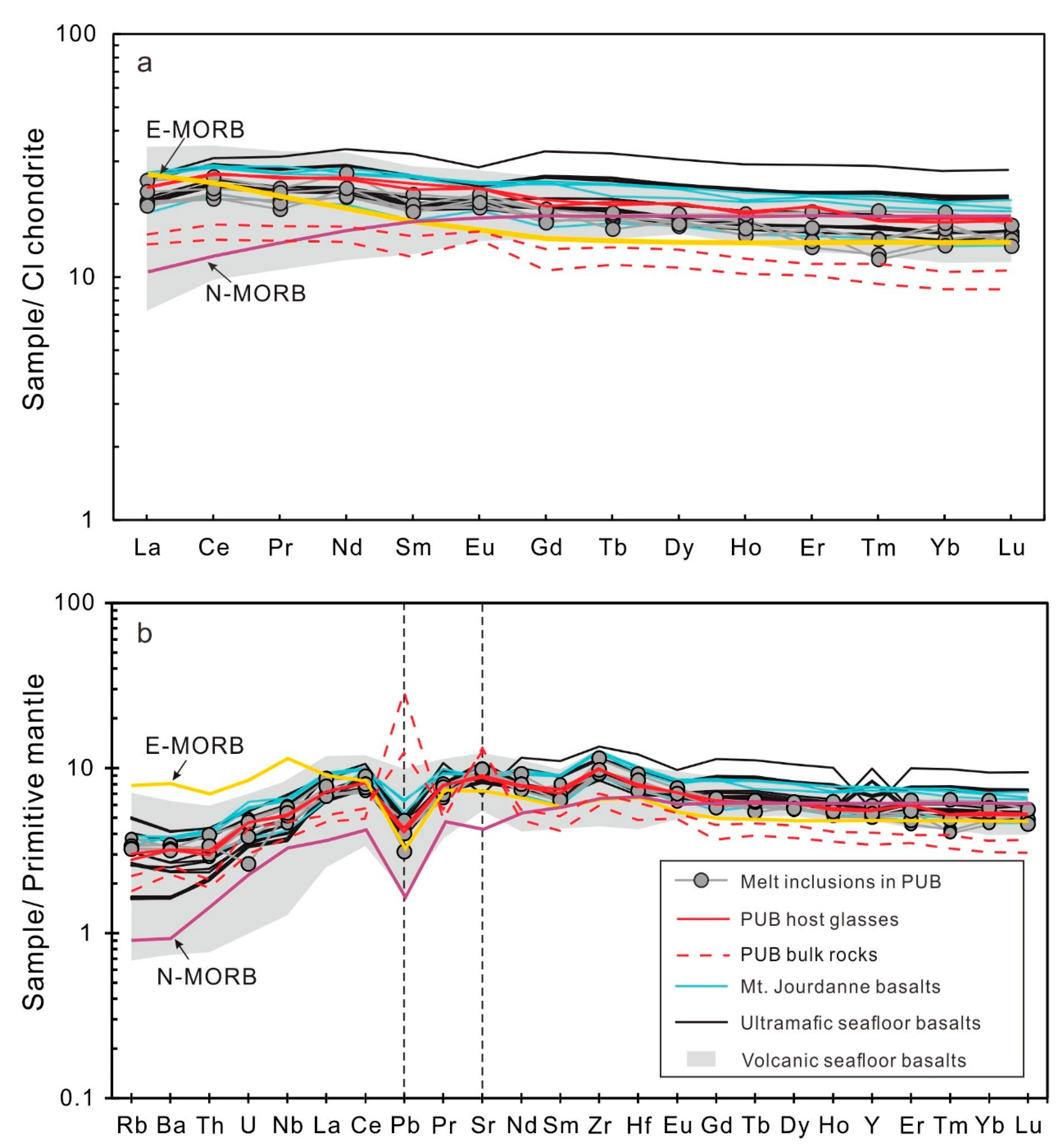
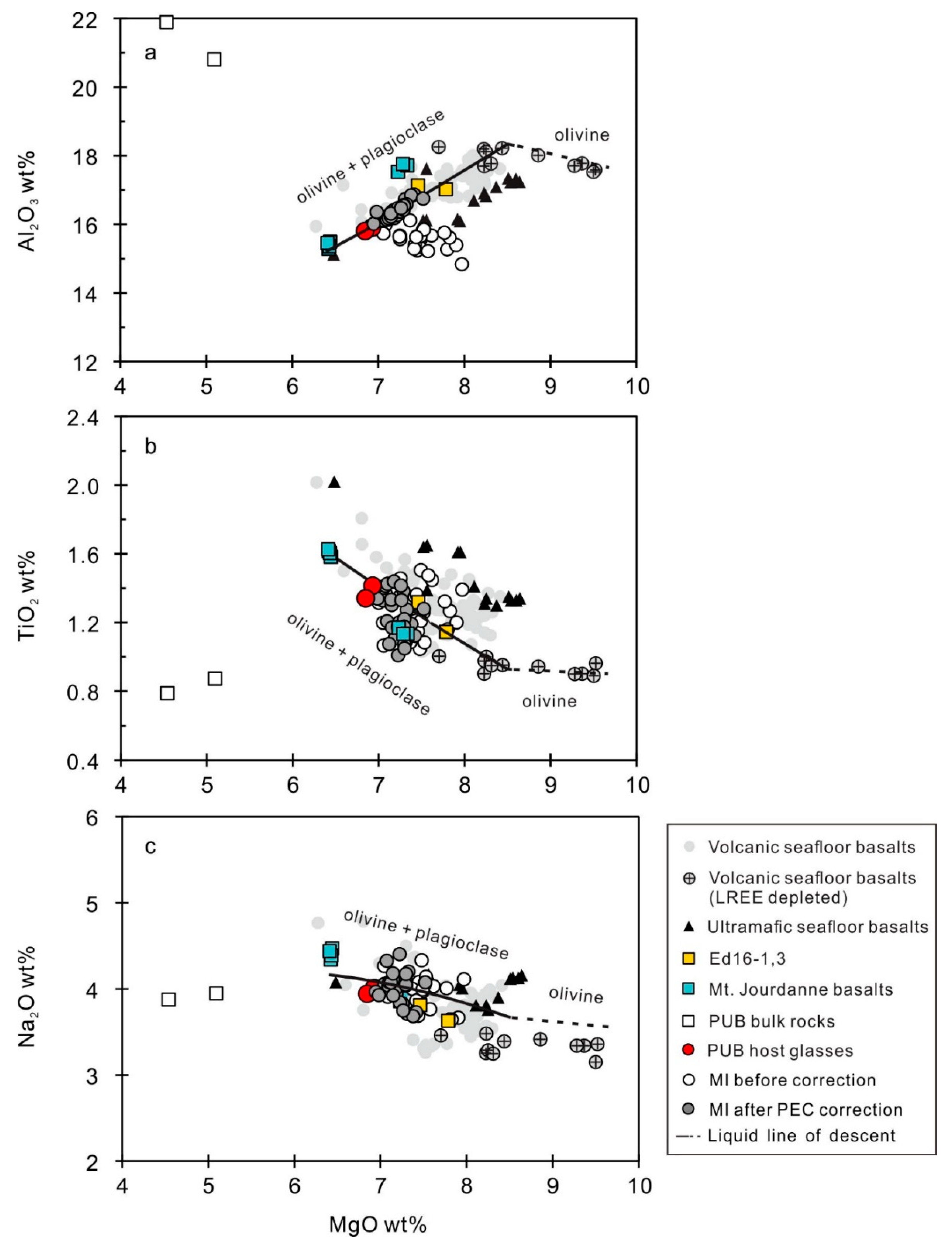
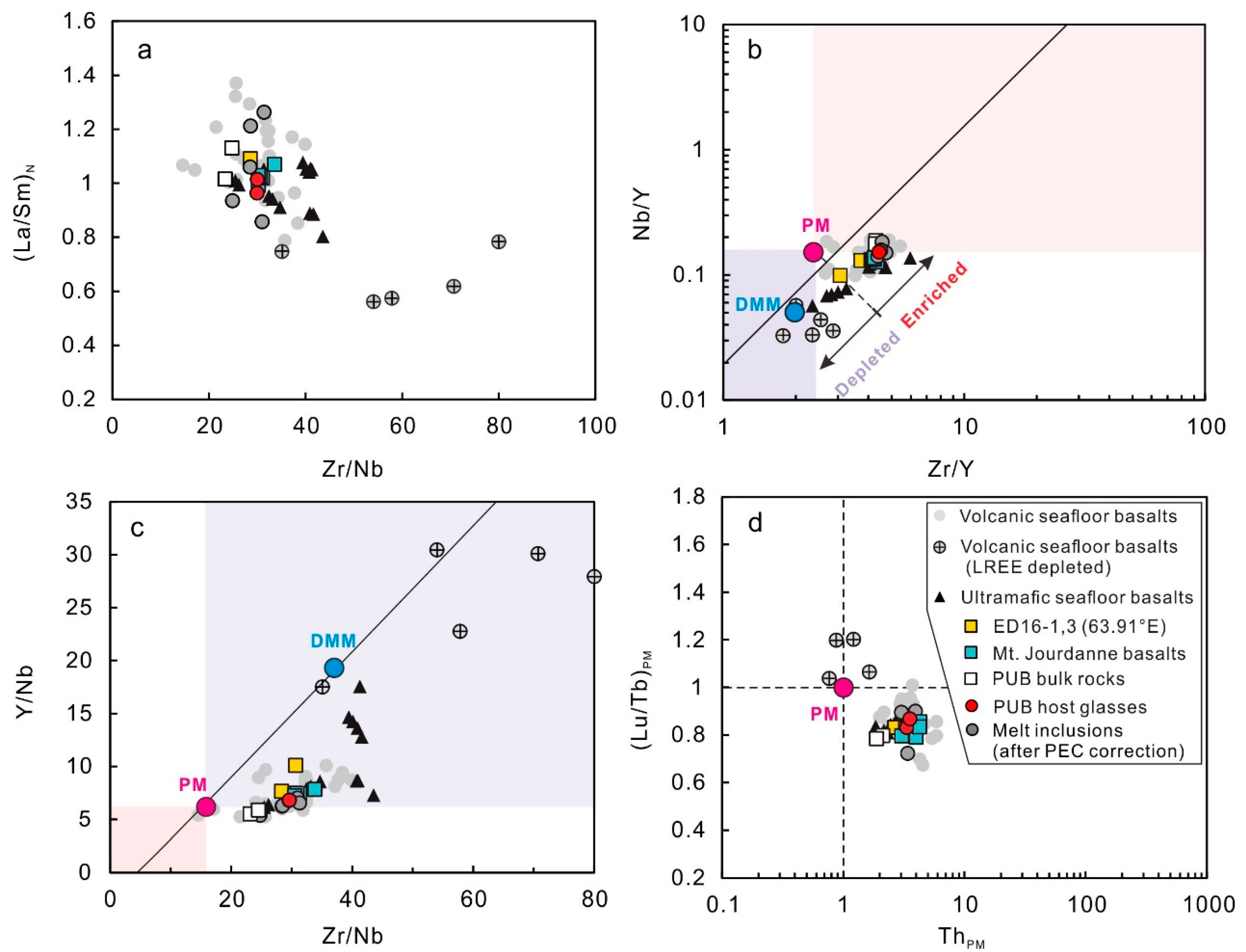


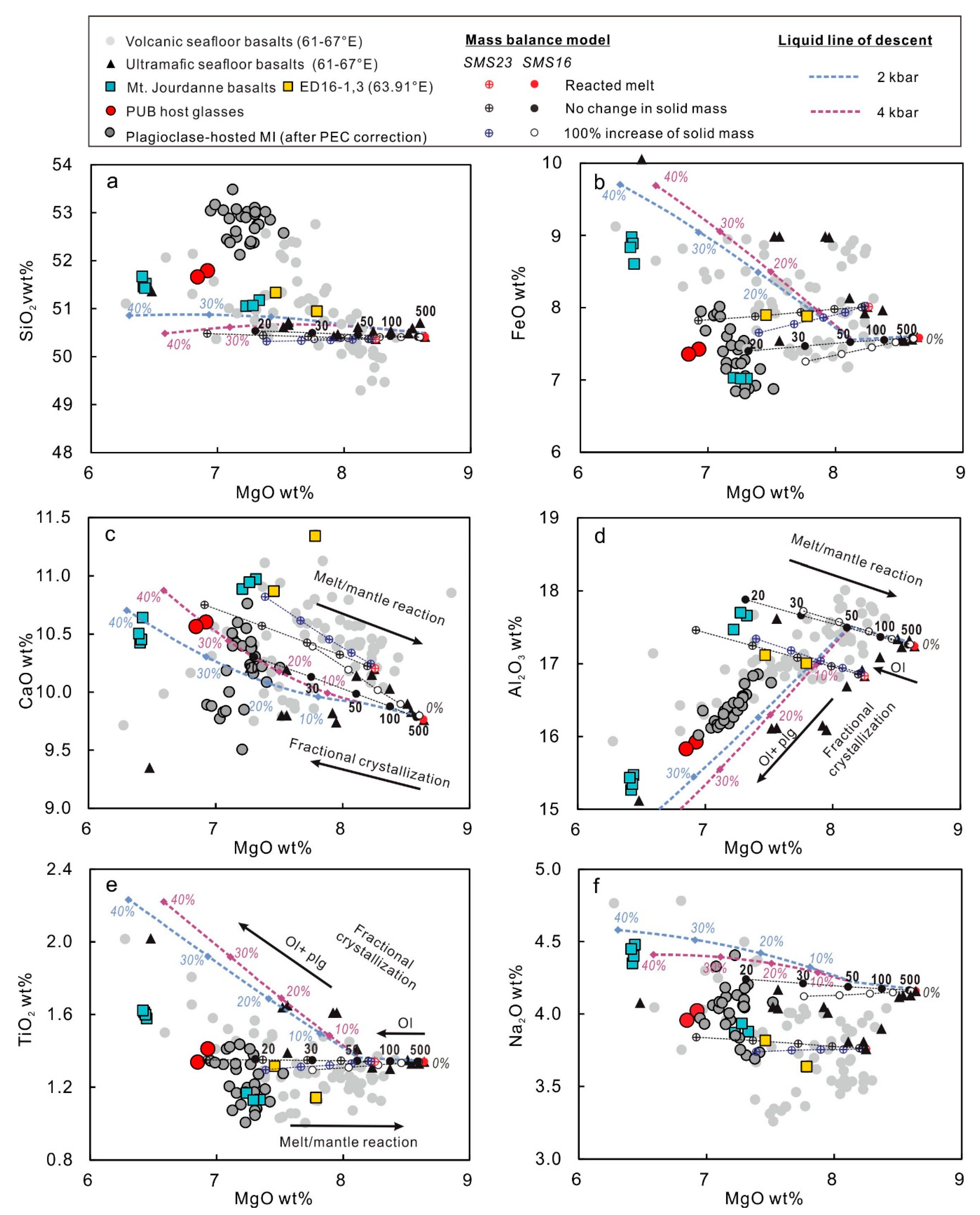
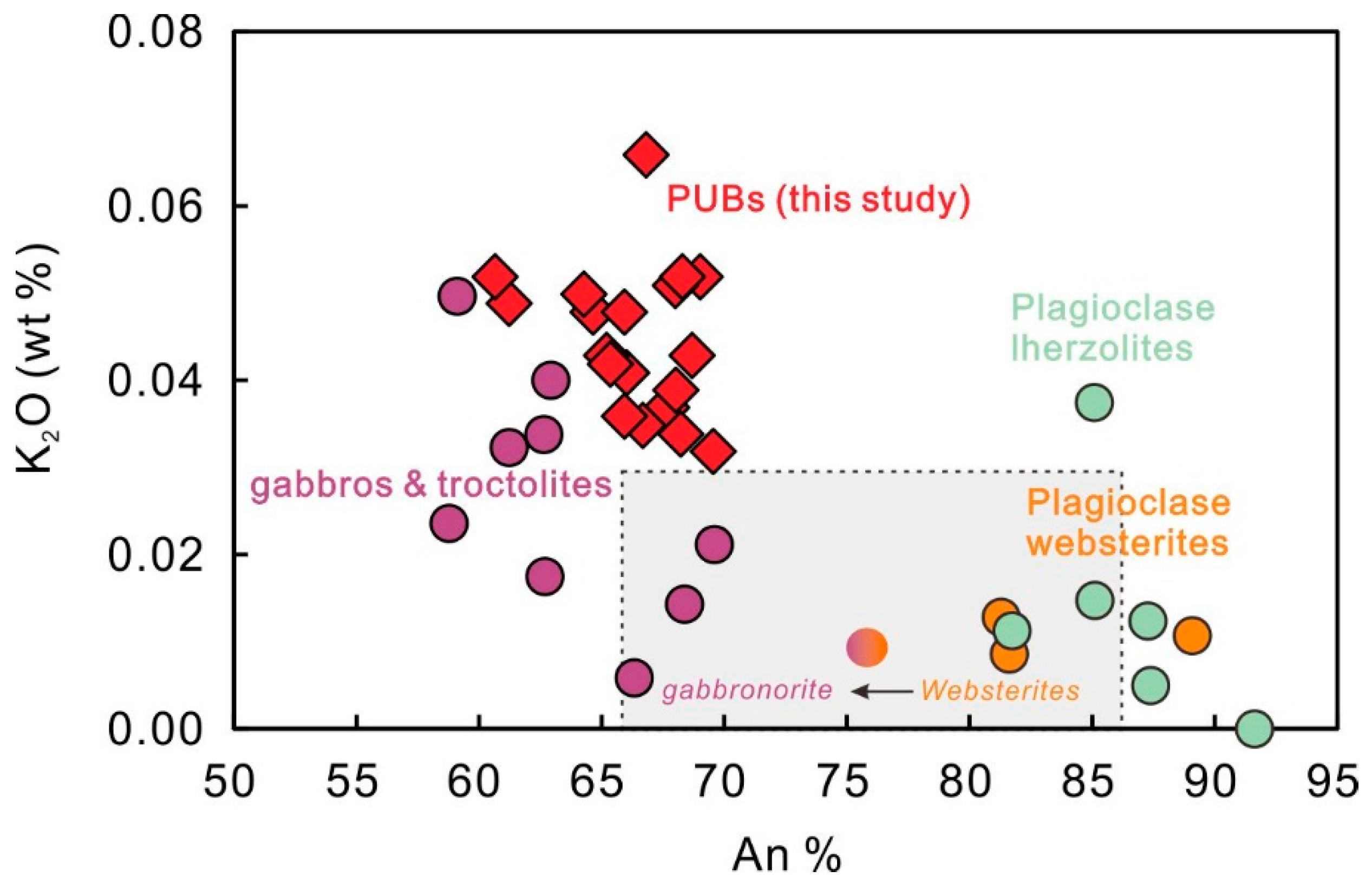
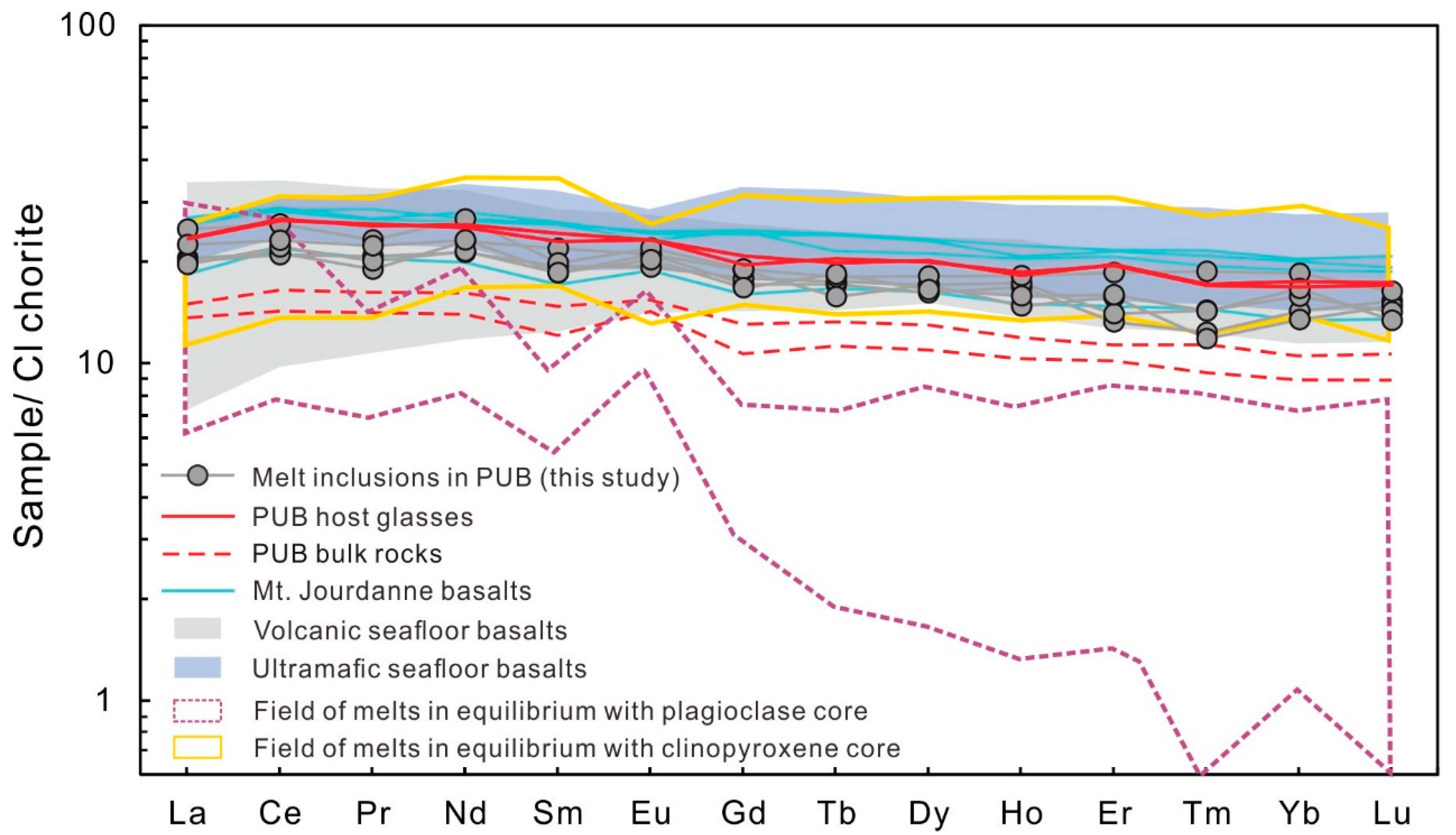

| Rock Sample | 49I-TVG01 | 49I-TVG01 1 | 20VII-TVG19-1 | 26VI-TVG02-1 | 26VI-TVG03-1 | 26VI-TVG03-1-2 | 19III-TVG3-1 | 30I-TVG2-1 | 30I-TVG2-2 |
|---|---|---|---|---|---|---|---|---|---|
| Longitude(° E) | 63.923 | 63.923 | 63.923 | 63.935 | 63.935 | 63.935 | 63.940 | 63.936 | 63.936 |
| Latitude(° S) | 27.851 | 27.851 | 27.851 | 27.842 | 27.849 | 27.849 | 27.850 | 27.849 | 27.849 |
| Depth(m) | 2743 | 2743 | 2759 | - | 2936 | 2936 | - | 2958 | 2958 |
| Major element (wt %) | |||||||||
| SiO2 | 51.17 | 51.06 | 51.04 | 51.51 | 51.42 | 51.66 | 51.45 | 51.16 | 51.48 |
| TiO2 | 1.14 | 1.13 | 1.17 | 1.58 | 1.60 | 1.63 | 1.62 | 0.87 | 0.79 |
| Al2O3 | 17.72 | 17.76 | 17.52 | 15.49 | 15.36 | 15.45 | 15.28 | 20.81 | 21.89 |
| Fe2O3 | 7.76 | 7.76 | 7.77 | 9.54 | 9.86 | 9.80 | 9.96 | 5.81 | 5.22 |
| FeO | - | - | - | - | - | - | - | - | - |
| MnO | 0.13 | 0.13 | 0.13 | 0.17 | 0.17 | 0.17 | 0.18 | 0.12 | 0.09 |
| MgO | 7.34 | 7.28 | 7.23 | 6.44 | 6.43 | 6.41 | 6.42 | 5.09 | 4.54 |
| CaO | 10.97 | 10.94 | 10.88 | 10.63 | 10.44 | 10.49 | 10.41 | 11.58 | 11.89 |
| Na2O | 3.86 | 3.92 | 3.86 | 4.47 | 4.39 | 4.44 | 4.34 | 3.95 | 3.88 |
| K2O | 0.20 | 0.20 | 0.23 | 0.26 | 0.28 | 0.29 | 0.27 | 0.18 | 0.17 |
| P2O5 | 0.14 | 0.14 | 0.14 | 0.19 | 0.20 | 0.20 | 0.20 | 0.11 | 0.10 |
| LOI | −0.41 | −0.35 | −0.22 | −0.40 | −0.60 | −0.40 | −0.39 | −0.04 | −0.10 |
| Total | 100.00 | 99.96 | 99.75 | 99.88 | 99.56 | 100.14 | 99.74 | 99.64 | 99.94 |
| K2O/TiO2 × 100 | 17.4 | 17.5 | 19.6 | 16.4 | 17.5 | 17.8 | 16.7 | 20.4 | 21.3 |
| Mg# | 0.65 | 0.65 | 0.65 | 0.57 | 0.56 | 0.56 | 0.56 | 0.63 | 0.63 |
| Trace element (ppm) | |||||||||
| Sc | 32.8 | 42.5 | 43.3 | 43.4 | 43.3 | 26.3 | 22.1 | ||
| V | 181 | 236 | 244 | 240 | 240 | 147 | 125 | ||
| Cr | 263 | 207 | 174 | 174 | 152 | 223 | 205 | ||
| Co | 33.2 | 33.2 | 34.6 | 34.2 | 35.1 | 132 | 104 | ||
| Ni | 93.4 | 43.7 | 41.3 | 42.0 | 41.2 | 58.4 | 48.8 | ||
| Cu | 65.8 | 82.5 | 82.8 | 85.0 | 88.3 | 60.5 | 44.9 | ||
| Zn | 68.5 | 68.7 | 70.6 | 72.9 | 124 | 42.7 | 35.3 | ||
| Rb | 1.77 | 2.16 | 2.47 | 2.64 | 2.36 | 1.42 | 1.15 | ||
| Sr | 232 | 195 | 195 | 201 | 186 | 271 | 283 | ||
| Y | 23.4 | 33.5 | 35.1 | 35.5 | 35.4 | 18.7 | 15.7 | ||
| Zr | 101 | 141 | 145 | 149 | 144 | 79.4 | 66.7 | ||
| Nb | 3.00 | 4.52 | 4.72 | 4.91 | 4.75 | 3.41 | 2.70 | ||
| Ba | 22.1 | 26.9 | 27.0 | 26.5 | 26.1 | 17.9 | 16.0 | ||
| La | 4.41 | 6.34 | 6.49 | 6.56 | 6.21 | 3.60 | 3.28 | ||
| Ce | 17.8 | 17.5 | 18.0 | 18.2 | 17.7 | 10.2 | 8.85 | ||
| Pr | 1.97 | 2.56 | 2.59 | 2.68 | 2.76 | 1.56 | 1.35 | ||
| Nd | 9.43 | 12.5 | 13.3 | 13.3 | 12.7 | 7.66 | 6.62 | ||
| Sm | 2.65 | 4.00 | 4.07 | 4.10 | 4.02 | 2.29 | 1.87 | ||
| Eu | 1.11 | 1.36 | 1.42 | 1.43 | 1.45 | 0.90 | 0.84 | ||
| Gd | 3.33 | 5.13 | 5.02 | 5.28 | 5.16 | 2.72 | 2.22 | ||
| Tb | 0.63 | 0.81 | 0.91 | 0.91 | 0.92 | 0.50 | 0.43 | ||
| Dy | 4.19 | 5.45 | 5.93 | 5.90 | 6.01 | 3.34 | 2.81 | ||
| Ho | 0.86 | 1.17 | 1.19 | 1.19 | 1.28 | 0.68 | 0.59 | ||
| Er | 2.47 | 3.48 | 3.60 | 3.61 | 3.63 | 1.90 | 1.70 | ||
| Tm | 0.37 | 0.50 | 0.54 | 0.56 | 0.56 | 0.29 | 0.24 | ||
| Yb | 2.31 | 3.25 | 3.45 | 3.23 | 3.52 | 1.80 | 1.54 | ||
| Lu | 0.35 | 0.48 | 0.50 | 0.52 | 0.53 | 0.27 | 0.23 | ||
| Hf | 2.28 | 2.96 | 3.11 | 2.93 | 3.21 | 1.93 | 1.51 | ||
| Ta | 0.22 | 0.28 | 0.30 | 0.32 | 0.31 | 0.87 | 0.49 | ||
| Pb | 0.76 | 1.20 | 0.99 | 0.95 | 1.17 | 2.33 | 5.48 | ||
| Th | 0.26 | 0.36 | 0.34 | 0.36 | 0.35 | 0.18 | 0.16 | ||
| U | 0.079 | 0.12 | 0.12 | 0.21 | 0.13 | 0.092 | 0.064 | ||
| Eu/Eu* | 1.14 | 0.92 | 0.96 | 0.94 | 0.97 | 1.11 | 1.26 | ||
| (La/Sm)N | 1.07 | 1.02 | 1.03 | 1.03 | 1.00 | 1.02 | 1.13 | ||
| (Sm/Yb)N | 1.28 | 1.37 | 1.31 | 1.41 | 1.27 | 1.41 | 1.35 | ||
| Sample | 30I-TVG2-1 | ||||||||||||||
| Rystal | C1-1 | C1-2 | C1-3 | C1-4 | C1-6 | C1-7 | C1-8 | ||||||||
| MI Inclusions | 1-1MI1 | 1-2MI1 | 1-2MI2 | 1-3MI1_1 | 1-3MI1_2 | 1-3MI2 | 1-4MI1 | 1-4MI2 | 1-6MI1 | 1-7MI1 | 1-7MI2 | 1-7MI3 | 1-7MI4 | 1-7MI5 | 1-8MI1 |
| Size (μm) | 200 | 80 | 250 | 50 | 80 | 50 | 250 | 75 | 35 | 40 | 40 | 60 | 60 | 40 | 70 |
| Major elements (wt %) | |||||||||||||||
| SiO2 | 52.73 | 51.74 | 52.72 | 52.06 | 52.14 | 52.6 | 52.58 | 53.01 | 52.49 | 52.3 | 51.71 | 51.99 | 51.8 | 52.16 | 53.29 |
| TiO2 | 1.32 | 1.41 | 1.34 | 1.16 | 1.2 | 1.27 | 1.2 | 1.36 | 1.24 | 1.15 | 1.19 | 1.46 | 1.5 | 1.45 | 1.05 |
| Al2O3 | 16.01 | 15.85 | 15.91 | 15.26 | 15.39 | 15.61 | 16.06 | 16 | 15.65 | 15.23 | 15.67 | 15.56 | 15.56 | 15.67 | 15.33 |
| Cr2O3 | 0.02 | 0.05 | 0.11 | 0.07 | 0.03 | 0.01 | 0.04 | 0.04 | 0.05 | 0.05 | 0.14 | 0.08 | 0.05 | 0.02 | |
| FeO | 7.83 | 7.88 | 7.89 | 7.89 | 7.56 | 7.28 | 7.96 | 7.78 | 7.59 | 7.71 | 7.68 | 8.02 | 8 | 7.84 | 7.02 |
| MnO | 0.13 | 0.09 | 0.17 | 0.15 | 0.15 | 0.13 | 0.15 | 0.12 | 0.14 | 0.07 | 0.08 | 0.14 | 0.14 | 0.09 | 0.15 |
| MgO | 7 | 7.04 | 6.9 | 7.8 | 7.91 | 7.83 | 7.05 | 7.09 | 7.45 | 7.45 | 7.25 | 7.25 | 7.49 | 7.62 | 7.48 |
| CaO | 9.69 | 9.65 | 9.81 | 9.72 | 9.62 | 9.85 | 9.76 | 9.76 | 9.61 | 10.35 | 10.22 | 10.02 | 10.22 | 10.04 | 9.22 |
| Na2O | 4.03 | 4.27 | 3.94 | 3.65 | 3.67 | 3.64 | 4.01 | 3.91 | 4.08 | 3.89 | 4.05 | 4.04 | 3.97 | 4.03 | 4.33 |
| K2O | 0.31 | 0.33 | 0.29 | 0.36 | 0.38 | 0.35 | 0.3 | 0.29 | 0.33 | 0.25 | 0.28 | 0.28 | 0.26 | 0.26 | 0.41 |
| P2O5 | 0.17 | 0.19 | 0.16 | 0.19 | 0.18 | 0.21 | 0.17 | 0.17 | 0.16 | 0.12 | 0.16 | 0.17 | 0.17 | 0.18 | 0.1 |
| Total | 99.21 | 98.51 | 99.23 | 98.3 | 98.23 | 98.79 | 99.27 | 99.49 | 98.78 | 98.58 | 98.33 | 99.08 | 99.19 | 99.39 | 98.41 |
| Mg# | 0.61 | 0.61 | 0.61 | 0.64 | 0.65 | 0.66 | 0.61 | 0.62 | 0.64 | 0.63 | 0.63 | 0.62 | 0.63 | 0.63 | 0.65 |
| Trace elements (ppm) | |||||||||||||||
| Rb | 2.18 | 2.37 | 2.14 | ||||||||||||
| Ba | 23.68 | 23.3 | 23.95 | ||||||||||||
| Th | 0.27 | 0.24 | 0.26 | ||||||||||||
| U | 0.1 | 0.09 | 0.08 | ||||||||||||
| Nb | 4.2 | 3.3 | 3.7 | ||||||||||||
| Ta | 0.23 | 0.18 | 0.21 | ||||||||||||
| La | 4.85 | 4.74 | 4.64 | ||||||||||||
| Ce | 12.97 | 12.83 | 13.54 | ||||||||||||
| Pb | 0.78 | 0.81 | 0.89 | ||||||||||||
| Pr | 1.8 | 1.97 | 1.91 | ||||||||||||
| Sr | 201 | 199 | 199 | ||||||||||||
| Nd | 10.74 | 9.93 | 10.02 | ||||||||||||
| Sm | 3.34 | 3.56 | 2.82 | ||||||||||||
| Zr | 104.44 | 101.48 | 104.3 | ||||||||||||
| Hf | 2.32 | 2.35 | 2.25 | ||||||||||||
| Eu | 1.22 | 1.31 | 1.22 | ||||||||||||
| Gd | 3.51 | 3.66 | 3.87 | ||||||||||||
| Tb | 0.64 | 0.65 | 0.59 | ||||||||||||
| Dy | 4.09 | 4.32 | 4.33 | ||||||||||||
| Ho | 0.95 | 0.83 | 0.98 | ||||||||||||
| Y | 22.76 | 23.03 | 22.94 | ||||||||||||
| Er | 2.18 | 2.59 | 2.31 | ||||||||||||
| Tm | 0.31 | 0.3 | 0.36 | ||||||||||||
| Yb | 2.42 | 2.28 | 2.68 | ||||||||||||
| Lu | 0.39 | 0.37 | 0.36 | ||||||||||||
| Eu/Eu* | 1.09 | 0.88 | 1.13 | ||||||||||||
| (La/Sm)N | 0.94 | 0.86 | 1.06 | ||||||||||||
| (Sm/Yb)N | 1.53 | 1.74 | 1.17 | ||||||||||||
| Sample | 30I-TVG2-2 | ||||||||||||||
| Crystal | C2-1 | C2-2 | C2-4 | C2-6 | C2-7 | C2-8 | |||||||||
| MI Inclusions | 2-1MI1 | 2-1MI2 | 2-2MI1 | 2-4MI | 2-6MI1 | 2-6MI2 | 2-7MI1 | 2-7MI2 | 2-8MI1 | 2-8MI2 | 2-8MI3 | 2-8MI4 | |||
| Size (μm) | 20 | 80 | 100 | 250 | 300 | 200 | 80 | 60 | 30 | 80 | 50 | 50 | |||
| Major elements (wt %) | |||||||||||||||
| SiO2 | 51.86 | 51.58 | 51.87 | 52.54 | 52.49 | 52.7 | 52.47 | 51.85 | 51.73 | 52.06 | 52.64 | 51.66 | |||
| TiO2 | 1.39 | 1.48 | 1.21 | 1.07 | 1.09 | 1.26 | 1.35 | 1.35 | 1.32 | 1.21 | 1.08 | 1.36 | |||
| Al2O3 | 14.84 | 15.21 | 15.39 | 15.73 | 16.11 | 15.84 | 15.28 | 15.64 | 15.75 | 15.65 | 15.84 | 15.62 | |||
| Cr2O3 | 0.02 | 0.07 | 0.1 | 0.03 | 0.1 | 0.03 | 0.05 | 0.14 | 0.04 | 0.05 | 0.02 | 0.09 | |||
| FeO | 7.39 | 7.76 | 7.39 | 7.31 | 6.94 | 6.97 | 7.46 | 7.22 | 7.05 | 7.43 | 7.23 | 7.36 | |||
| MnO | 0.15 | 0.18 | 0.19 | 0.09 | 0.14 | 0.02 | 0.14 | 0.11 | 0.18 | 0.09 | 0.12 | 0.16 | |||
| MgO | 7.97 | 7.58 | 7.43 | 7.06 | 7.37 | 7.52 | 7.42 | 7.25 | 7.77 | 7.49 | 7.53 | 7.44 | |||
| CaO | 9.9 | 10.22 | 10.03 | 9.78 | 10.22 | 10.17 | 10.13 | 10.28 | 9.89 | 10.2 | 10.01 | 10.49 | |||
| Na2O | 4.11 | 3.76 | 3.76 | 4 | 4 | 4.06 | 3.87 | 4.11 | 4.01 | 3.99 | 4.14 | 3.69 | |||
| K2O | 0.33 | 0.23 | 0.25 | 0.32 | 0.31 | 0.32 | 0.27 | 0.25 | 0.31 | 0.29 | 0.32 | 0.26 | |||
| P2O5 | 0.15 | 0.21 | 0.15 | 0.15 | 0.15 | 0.1 | 0.16 | 0.18 | 0.13 | 0.18 | 0.14 | 0.22 | |||
| Total | 98.1 | 98.28 | 97.76 | 98.06 | 98.92 | 99 | 98.6 | 98.38 | 98.17 | 98.62 | 99.08 | 98.35 | |||
| Mg# | 0.66 | 0.64 | 0.64 | 0.63 | 0.65 | 0.66 | 0.64 | 0.64 | 0.66 | 0.64 | 0.65 | 0.64 | |||
| Trace elements (ppm) | |||||||||||||||
| Rb | 2.07 | 2.05 | |||||||||||||
| Ba | 22.57 | 22.13 | |||||||||||||
| Th | 0.33 | 0.29 | |||||||||||||
| U | 0.1 | 0.06 | |||||||||||||
| Nb | 4.1 | 3.8 | |||||||||||||
| Ta | 0.31 | 0.17 | |||||||||||||
| La | 5.93 | 5.32 | |||||||||||||
| Ce | 15.85 | 14.16 | |||||||||||||
| Pb | 0.58 | 0.74 | |||||||||||||
| Pr | 2.21 | 2.11 | |||||||||||||
| Sr | 208 | 207 | |||||||||||||
| Nd | 12.5 | 10.81 | |||||||||||||
| Sm | 3.03 | 2.84 | |||||||||||||
| Zr | 128.4 | 109.04 | |||||||||||||
| Hf | 2.84 | 2.61 | |||||||||||||
| Eu | 1.27 | 1.17 | |||||||||||||
| Gd | 3.9 | 3.43 | |||||||||||||
| Tb | 0.67 | 0.69 | |||||||||||||
| Dy | 4.6 | 4.18 | |||||||||||||
| Ho | 1.03 | 0.89 | |||||||||||||
| Y | 26.97 | 24.09 | |||||||||||||
| Er | 3.06 | 2.64 | |||||||||||||
| Tm | 0.48 | 0.36 | |||||||||||||
| Yb | 3.14 | 2.83 | |||||||||||||
| Lu | 0.41 | 0.34 | |||||||||||||
| Eu/Eu* | 1.13 | 1.15 | |||||||||||||
| (La/Sm)N | 1.26 | 1.21 | |||||||||||||
| (Sm/Yb)N | 1.07 | 1.12 | |||||||||||||
| Proportion of Phases (wt %) | |||||||||
|---|---|---|---|---|---|---|---|---|---|
| Pressure | T | Liq | Plg | Cpx | Sp | An 2 | D (Liq) 3 | D (Plg) 3 | D (Cpx) 3 |
| 1kbar | 1212 4 | 99.94 | 0.06 | - | - | 70 | 2.636 | 2.654 | - |
| 1192 | 84.40 | 10.79 | 4.09 | - | 65 | 2.646 | 2.645 | 3.215 | |
| 2kbar | 1217 4 | 98.93 | 1.03 | - | - | 68 | 2.652 | 2.654 | - |
| 1207 | 87.23 | 7.35 | 5.36 | 0.07 | 65 | 2.655 | 2.648 | 3.218 | |
| 4kbar | 1245 | 98.61 | - | 1.39 | - | - | 2.674 | - | 3.219 |
| 1235 4 | 91.75 | 1.23 | 5.64 | - | 65 | 2.671 | 2.654 | 3.226 | |
| 6kbar | 1280 | 99.94 | - | 0.06 | - | - | 2.697 | - | 3.219 |
| 1250 4 | 83.36 | 1.65 | 14.99 | - | 62 | 2.688 | 2.654 | 3.242 | |
| 8kbar | 1302 | 94.48 | - | 5.52 | - | - | 2.719 | - | 3.228 |
| 1262 4 | 75.87 | 2.08 | 22.06 | - | 59 | 2.704 | 2.655 | 3.260 | |
© 2019 by the authors. Licensee MDPI, Basel, Switzerland. This article is an open access article distributed under the terms and conditions of the Creative Commons Attribution (CC BY) license (http://creativecommons.org/licenses/by/4.0/).
Share and Cite
Li, W.; Tao, C.; Zhang, W.; Liu, J.; Liang, J.; Liao, S.; Yang, W. Melt Inclusions in Plagioclase Macrocrysts at Mount Jourdanne, Southwest Indian Ridge (~64° E): Implications for an Enriched Mantle Source and Shallow Magmatic Processes. Minerals 2019, 9, 493. https://doi.org/10.3390/min9080493
Li W, Tao C, Zhang W, Liu J, Liang J, Liao S, Yang W. Melt Inclusions in Plagioclase Macrocrysts at Mount Jourdanne, Southwest Indian Ridge (~64° E): Implications for an Enriched Mantle Source and Shallow Magmatic Processes. Minerals. 2019; 9(8):493. https://doi.org/10.3390/min9080493
Chicago/Turabian StyleLi, Wei, Chunhui Tao, Wen Zhang, Jia Liu, Jin Liang, Shili Liao, and Weifang Yang. 2019. "Melt Inclusions in Plagioclase Macrocrysts at Mount Jourdanne, Southwest Indian Ridge (~64° E): Implications for an Enriched Mantle Source and Shallow Magmatic Processes" Minerals 9, no. 8: 493. https://doi.org/10.3390/min9080493




